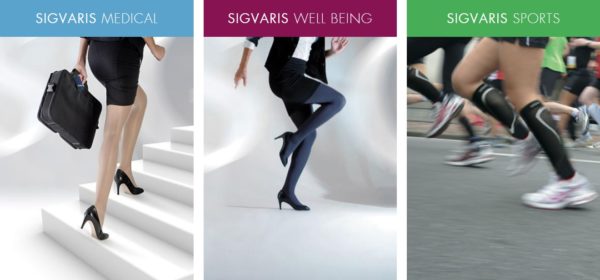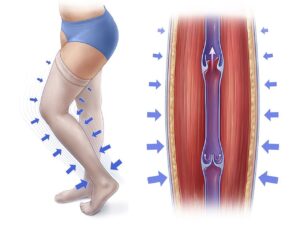Compression therapy
SIGVARIS® Compression Stocking Therapy

What is compression therapy?
Medical compression therapy consists of applying a type of elastic device, mainly on the limbs, to exert controlled pressure on them. By compressing the limbs or other body regions, the medical compression device squeezes the vein walls together, thereby improving overall circulation and supporting blood flow back toward the heart.
In addition, it helps to reduce swelling and formation of edema in edematous tissues by reducing the capillary leakage into the tissue and supports the lymphatic drainage of interstitial fluid. Medical compression provides significant relief of leg aching, pain, feeling of swelling and heaviness, and other venous and lymphatic symptoms.
Different materials, forms, and styles are available
Medical compression can be applied in different pressure degrees, forms, and styles and materials based on the symptoms and needs of individuals. Round- and flat-knitted garments (stockings, leggings, shorts, tights, pantyhose, arm sleeves, gloves, etc.), wraps, and bandages are available.
We have a wide range of Sigvaris compression stockings. Those include compression stockings with relatively low compression levels that can be purchased without a prescription at our Home Health Care store, as well as compression stockings with higher levels of compression that are prescribed by doctors.
Over-the-counter stockings usually come in compression levels of around 15-20 mmHg.
By “high-level compression,” we mean those that generally range from 20-30 mmHg to 30-40 mmHg; while these strengths are generally safe to wear, certain individuals may be at risk of harm due to contraindications – the oversight of a doctor is always recommended. Compression levels in even higher ranges do exist, but your doctor should tell you about those.
Compression levels explained
8-15 mmHg
- Mildly aching and tired legs
- Support and comfort for either standing or sitting for long periods
- When just a little support is needed for general health and energy
15-20 mmHg
- Slightly more support, offering day-to-day relief from achy, heavy, and slightly swollen legs
- Extra support on busy, active days, or when travelling
- An aid for enhanced circulation, especially in the legs
- During pregnancy they can help prevent varicose and spider veins
20-30 mmHg
- The most commonly prescribed compression level by Doctors
- Used to help a variety of minor to moderate medical conditions
- Helps chronically painful and heavily fatigued legs
- Helpful in the treatment of varicose veins
- Relief from the swelling associated with mild edema
- Used in combination with elective surgical procedures such as sclerotherapy and phlebectomy
- Used to help treat orthostatic/postural hypotension, a form of low blood pressure
30-40 mmHg
- Relief from moderate to severe edema and lymphedema
- Helps prevent and relieve more serious cases of varicose veins
- Used in the treatment of Deep Vein Thrombosis (DVT) and Post Thrombotic Syndrome
- Can help heel active venous stasis ulcers
- Used to treat phlebitis
- Used in treating skin changes with healed ulceration
40-50 mmHg
- Used as part of the treatment for chronic venous insufficiency
- Used for the most severe cases of DVT and Post Thrombotic Syndrome
- Used in treating severe skin changes with active ulceration
The effects of medical compression

Effect on blood circulation
The controlled pressure exerted by medical compression stockings reduces the diameter of major veins, thereby increasing the velocity and volume of blood flow. Consequently, medical compression improves blood transport from the extremities towards the heart, reduces blood reflux and stagnation, and provides better drainage of the deep venous system, which all helps to increase and therefore improve the circulatory rate.
Effect on edematous tissue
Under medical compression, the balance in blood exchange is improved by reducing capillary leakage of fluid in the interstitial tissue. This leads to a better reduction of edema. A beneficial massaging effect of certain medical compression textiles, leading to a softening of hardened or fibrotic tissue, has been reported.
In addition, medical compression recreates conditions beneficial for the healing of chronic inflammatory disorders (e.g. cellulitis, erysipelas, venous leg ulcers, etc.), through reduced pro‐inflammatory cytokine levels and higher levels of the anti‐inflammatory cytokines. Also, improved skin microcirculation has been reported.
Speak with us for more details.
